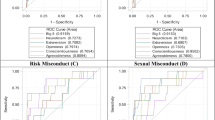Abstract
Infidelity is a major factor in causing marital dissolution and dissatisfaction in North America. Similarities in personality traits influence the desire for a monogamous relationship commitment. The present study examined differences between cheaters and non-cheaters on Goldberg’s (1990) “Big-Five Personality Factors”: Extroversion, Agreeableness, Conscientiousness, Emotional Stability, and Intellect-Openness. One hundred and four participants volunteered to answer a questionnaire on personality traits about themselves and their monogamous partners. A total of 45 males and 59 females rated themselves and an equal number of partners on the traits (n = 208). Results revealed statistically significant differences between cheaters and non-cheaters on the five-factor model. Differences were also found between both of the group’s perceptions of themselves and their monogamous partners on these factors.
Similar content being viewed by others
References
Botwin, M.D., Buss, D.M. & Shackelford, T.K. (1997). Personality and mate preferences: Five factors in mate selection and marital satisfaction. Journal of Personality, 65, 107–136.
Buss, D.M. & Shackelford, T.K. (1997). Susceptibility to infidelity in the first year of marriage. Journal of Research in Personality, 31, 193–221.
Costa, P.T., Jr., & McCrae, R.R. (1992). Revised NEO Personality Inventory (NEO-PI-R) and NEO Five-Factor Inventory (NEO-FFI) professional manual. Odessa, FL: Psychological Assessment Resources.
Costa, P.T., Jr., & Widiger, T.A. (1994). Personality disorders and the five-factor model of personality. Washington, D.C.: American Psychological Association.
Drigotas, S.M. & Barta, W. (2001). The cheating heart: Scientific exploration of infidelity. Current Directions in Psychological Science, 10, 177–180.
Drigotas, S.M., Safstrom, CA. & Gentilia, T. (1999). An investment model prediction of dating infidelity. Journal of Personality and Social Psychology, 77, 509–524.
Feldman, S.S. & Cauffman, E. (1999a). Your cheatin' heart: Sexual betrayal attitudes and behaviours and their correlates. Journal of Research on Adolescence, 9, 227–257.
Feldman, S.S. & Cauffman, E. (1999b). Sexual betrayal among late adolescents: Perspectives of the perpetrator and the aggrieved. Journal of Youth and Adolescence, 28, 235–258.
Glass, G.Z. & Wright, T.L. (1985). Sex differences in type of extramarital involvement and marital dissatisfaction. Sex Roles, 12, 1101–1120.
Goldberg, L.R. (1982). From Ace to Zombie: Some explorations in the language of personality. In CD. Spielberger & J.N. Butcher (Eds.), Advances in personality assessment (Volume 1, pp. 203–234). Hillsdale, NJ: Erlbaum.
Goldberg, L.R. (1990). An alternative “description of personality”: The Big-Five factor structure. Journal of Personality and Social Psychology, 59 (6), 1216–1229.
Graziano, W.G. & Eisenberg, N.H. (1997). Agreeableness: A dimension of personality. In R. Hogan, J. Johnson, & S. Briggs (Eds.), Handbook of personality psychology (pp. 795–824). San Diego, CA: Academic.
Hansen, G.L. (1985). Extra dyadic reactions during courtship. Journal of Sex Research, 23, 382–390.
Hendrick, S. & Hendrick, C. (1987). Multidimensionality of sexual attitudes. The Journal of Sex Research, 23, 502–526.
Hogan, J. & Ones, D.S. (1997). Conscientiousness and integrity at work. In R. Hogan, J. Johnson, & S. Briggs (Eds.), Handbook of personality psychology (pp. 849–870). San Diego, CA: Academic.
Judge, T.A., Higgins, CA., Thoresen, C.J. & Barrick, M.R. (1999). The Big Five personality traits, general mental ability and career success across the life span. Personal Psychology, 52, 621–652.
Kinsey, A.C., Pomeroy, W.B., Martin, CE. & Gebhard, P.H. (1953). Sexual behaviour in the human female. Philadelphia: Saunders.
Kosek (1996). The quest for a perfect spouse: Spousal ratings and marital satisfaction. Psychological Reports, 79, 731–735.
Kurdek, L. (1993). Predicting marital dissolution: A 5-year prospective longitudinal study of newlywed couples. Journal of Personality and Social Psychology, 64, 221–242.
Lawson, A. & Samson, C. (1988). Age, gender and adultery. The British Journal of Sociology, 39, 409–440.
Linton, D.K. & Wiener, N.I. (2001). Personality and potential conceptions: Mating success in a modern western male sample. Personality and Individual Differences, 31, 675–688
Luo, S. &. Klohnen, E. (2005). Assortative mating and marital quality in newlyweds: A couple-centered approach. Journal of Personality and Social Psychology, 88 (2), 304–326.
McCrae, R. & Costa, P. (1987). Validation of the five-factor model of personality across instruments and observers. Journal of Personality and Social Psychology, 52, 81–90.
Myers, D.G. & Spencer, S. J. (Canadian Ed.) (2001). Attraction and intimacy: Liking and loving others. Social Psychology (pp.428–471). Toronto: McGraw-Hill Ryerson Limited.
Peabody, D. & Goldberg, L. (1989). Some determinants of factor structures from personality-trait descriptors. Journal of Personality and Social Psychology, 57 (3), 552–567.
Rice, F. P. (1984). The adolescent: Development, relations, and culture (4th ed.). Boston: Allyn and Bacon.
Roscoe, B., Cavanaugh, L. and Kennedy, D. (1988). Dating infidelity: Behaviours, reasons, and consequences. Adolescence, 23, 35–43.
Rusbult, CE. (1983). A longitudinal test of the investment model: The development (and deterioration) of satisfaction and commitment in heterosexual involvement. Journal of Personality and Social Psychology, 45, 101–117.
Schmitt, D. (2004). The big-five related to risky sexual behaviour across 10 world regions: Differential personality associations of sexual promiscuity and relationship infidelity. European Journal of personality, 75, 301–319.
Seidman, S.N., & Reider, R. (1994). A review of sexual behaviour in the United States. American Journal of Psychiatry, 151,330–341.
Shaver, P.R., & Brennan, K.. A. (1992). Attachment styles and the big-five personality traits: Their connections with each other and with romantic relationship outcomes. The Society for Personality and Social Psychology, 18, 536–545.
Sheppard, V., Nelson, E., & Andreoli-Mathis. (1995). Dating relationships and infidelity: Attitudes and behaviour. Journal of Sex and Marital Therapy, 21, 202–212.
Thompson, A. P. (1984). Emotional and sexual components of extramarital relations. Journal of Marriage and the Family, 46, 35–42.
Watson, D. Hubbard, B., & Wiese, D. (2000). General traits of personality and affectivity as predictors of satisfaction in intimate relationships: Evidence from self-and partner-ratings. Journal of Personality, 68 (3), 413–449.
Author information
Authors and Affiliations
Corresponding author
Additional information
We wish to thank the editor and reviewers of this journal for their helpful and precise comments towards revisions of this publication. The primary author also wishes to thank Dr. Kevin Alderson for his suggestions on earlier drafts of this paper.
Rights and permissions
About this article
Cite this article
Orzeck, T., Lung, E. Big-five personality differences of cheaters and non-cheaters. Curr Psychol 24, 274–286 (2005). https://doi.org/10.1007/s12144-005-1028-3
Issue Date:
DOI: https://doi.org/10.1007/s12144-005-1028-3




